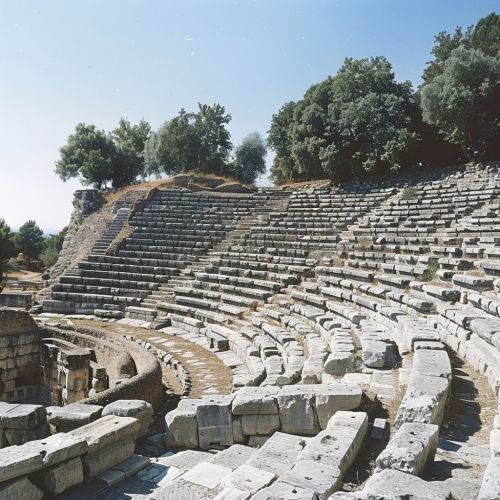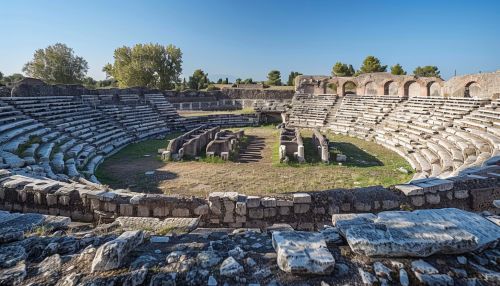Lugdunum
Introduction
Lugdunum, known today as Lyon, was an important city in the Roman Empire. Founded in 43 BCE by Lucius Munatius Plancus, it served as the capital of the Roman province of Gallia Lugdunensis. Its strategic location at the confluence of the Rhône and Saône rivers made it a crucial hub for trade, military, and administrative activities. Over the centuries, Lugdunum evolved into a significant cultural and economic center, leaving a lasting legacy that continues to be felt in modern Lyon.
Historical Background
Foundation and Early Development
Lugdunum was established in 43 BCE by Lucius Munatius Plancus, a Roman general, on the orders of the Senate. The site was chosen for its strategic advantages, including its elevated position and proximity to the confluence of the Rhône and Saône rivers. This location facilitated trade and communication with other parts of the Roman Empire.
The city's early development was marked by the construction of essential infrastructure, including roads, bridges, and aqueducts. The Via Agrippa, a major Roman road, connected Lugdunum to other important cities such as Narbo Martius (modern Narbonne) and Augusta Treverorum (modern Trier). This network of roads played a crucial role in the city's growth and prosperity.
Roman Administration and Governance
Lugdunum served as the administrative capital of the province of Gallia Lugdunensis. The city's governance was overseen by a Roman governor, who was responsible for maintaining law and order, collecting taxes, and overseeing public works. The governor was supported by a council of local elites, known as the ordo decurionum, who played a significant role in the city's administration.
The city also hosted the annual assembly of the Concilium Galliarum, a council of representatives from the various Gallic tribes. This assembly was an important forum for discussing matters of regional governance and fostering loyalty to the Roman Empire.
Urban Development and Architecture
Public Buildings and Monuments
Lugdunum was renowned for its impressive public buildings and monuments, which reflected the city's importance and prosperity. One of the most notable structures was the amphitheater, which could accommodate up to 20,000 spectators. The amphitheater hosted various public spectacles, including gladiatorial games, theatrical performances, and public executions.
Another significant landmark was the Temple of Augustus and Livia, dedicated to the deified Emperor Augustus and his wife Livia. The temple was a focal point of religious life in the city and a symbol of the emperor's divine authority.


Residential Areas and Housing
The residential areas of Lugdunum were characterized by a mix of luxurious villas and modest insulae (apartment buildings). The villas were typically owned by wealthy elites and featured elaborate mosaics, frescoes, and private baths. In contrast, the insulae were multi-story buildings that housed the city's lower and middle classes.
The city's layout was organized along a grid pattern, with wide streets and public squares. The forum was the heart of civic life, serving as a marketplace and a venue for public gatherings.
Infrastructure and Public Services
Lugdunum boasted advanced infrastructure and public services, including an extensive network of aqueducts that supplied the city with fresh water. The most famous of these was the Aqueduct of the Gier, which brought water from the Mont Pilat region to the city. The aqueducts were engineering marvels, featuring arches, tunnels, and bridges to navigate the challenging terrain.
The city also had an efficient sewage system, with underground drains and public latrines. These facilities contributed to the overall health and hygiene of the urban population.
Economy and Trade
Commercial Activities
Lugdunum was a thriving commercial center, thanks to its strategic location and well-developed infrastructure. The city's economy was diverse, encompassing agriculture, manufacturing, and trade. The fertile lands surrounding Lugdunum produced a variety of crops, including wheat, barley, and grapes. The region was also known for its vineyards, which produced high-quality wine that was exported throughout the Roman Empire.
The city's artisans were skilled in various crafts, including pottery, metalworking, and textiles. Lugdunum was particularly renowned for its production of sigillata pottery, a type of fine red-gloss ware that was highly prized across the empire.
Trade Networks
Lugdunum's position at the confluence of the Rhône and Saône rivers made it a key node in the Roman trade network. The rivers facilitated the transport of goods to and from the Mediterranean Sea, while the city's road connections enabled trade with other parts of Gaul and beyond.
The city's merchants engaged in both local and long-distance trade, dealing in a wide range of goods, including agricultural produce, manufactured items, and luxury goods. Lugdunum was also a center for the trade of slaves, who were brought to the city from various parts of the empire.
Cultural and Social Life
Religion and Worship
Religion played a central role in the life of Lugdunum's inhabitants. The city was home to numerous temples and shrines dedicated to various Roman deities, including Jupiter, Juno, and Minerva. The Temple of Augustus and Livia was one of the most important religious sites in the city, serving as a focal point for the worship of the imperial cult.
In addition to Roman deities, the city's diverse population also worshipped a variety of local and foreign gods. The Mithraeum of Lugdunum, dedicated to the Persian god Mithras, is a testament to the city's religious diversity.
Education and Learning
Lugdunum was a center of education and learning, attracting scholars and students from across the Roman Empire. The city boasted several schools and libraries, where subjects such as rhetoric, philosophy, and law were taught. The presence of these institutions contributed to the city's reputation as a hub of intellectual activity.
The city's elites often sent their children to study in Lugdunum, where they received a comprehensive education that prepared them for careers in public service, law, and other professions.
Entertainment and Leisure
The inhabitants of Lugdunum enjoyed a variety of entertainment and leisure activities. The city's amphitheater hosted gladiatorial games, theatrical performances, and other public spectacles. The thermae, or public baths, were another popular venue for relaxation and socializing. These facilities included hot and cold baths, exercise areas, and spaces for social gatherings.
The city's residents also participated in various festivals and religious celebrations, which were important occasions for community bonding and cultural expression.
Decline and Legacy
Late Antiquity and Decline
Lugdunum's fortunes began to decline in the late antiquity period, as the Roman Empire faced increasing internal and external pressures. The city suffered from invasions by Germanic tribes, economic difficulties, and political instability. By the 5th century CE, Lugdunum had lost much of its former prominence and was gradually overshadowed by other regional centers.
Despite its decline, the city's legacy endured. Many of Lugdunum's architectural and cultural achievements influenced the development of medieval and modern Lyon. The city's Roman heritage is still evident in its archaeological sites, museums, and cultural institutions.
Modern Lyon and Historical Preservation
Today, Lyon is a vibrant city that honors its Roman past. The city's archaeological sites, including the amphitheater and the Temple of Augustus and Livia, are preserved and open to the public. The Musée Gallo-Romain de Lyon-Fourvière houses an extensive collection of artifacts from Lugdunum, providing valuable insights into the city's history and culture.
Lyon's Roman heritage is also celebrated through various cultural events and festivals, which attract visitors from around the world. These efforts to preserve and promote the city's historical legacy ensure that the story of Lugdunum continues to be told for generations to come.
